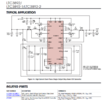TantalumPolytope
New Member
I'm building a 60V 10A lab PSU and i'm almost done with all the circuits. i just need a 0 to 10A current limiting circuit. prefferably using 4 TIP3055 in parallel for the limiting. if possible, a 10 mOhm shunt would be nicer than a 100 mOhm shunt since it can be lower wattage.
i am pretty inexperienced in making my own circuits so any help would be greatly appreciated!
i am pretty inexperienced in making my own circuits so any help would be greatly appreciated!


